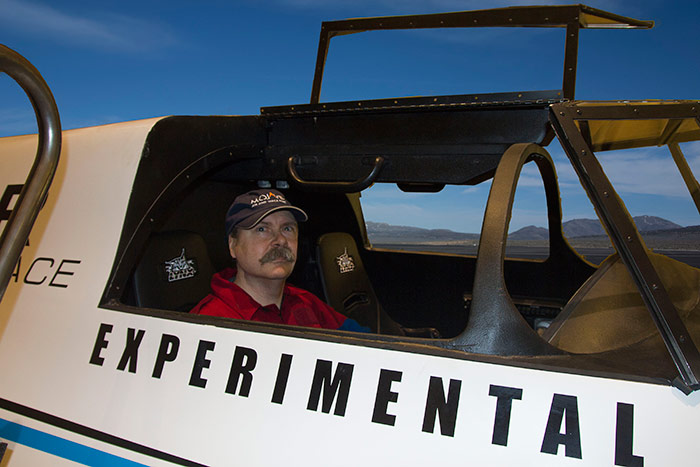The 1983 motion picture The Right Stuff shows a classic scene where the Mercury astronauts confront a German engineer (obviously modeled after Wernher von Braun, although never referred to by name). The astronauts have decided to take control and “change the parameters of the experiment.” They insist on changes to the Mercury capsule including the addition of a window, a hatch with explosive bolts, and a stick that will allow the astronaut to take manual control. During the tense confrontation, Alan Shepard (played by Scott Glenn) challenges NASA’s nomenclature: “That is a spacecraft, sir. We do not refer to it as a capsule.”
Such exchanges between astronauts and engineers did take place during the Mercury program, although the staging was much less dramatic and Von Braun was not actually involved. The astronauts insisted on all the design changes that were mentioned in the film and they vehemently objected to calling Mercury a “capsule” – which sounded like something an astronaut might swallow. Spacecraft was the term the astronauts preferred.
With all due respect to Alan Shepard and the others, Mercury had much more in common with an aviation escape capsule than it did an aircraft. Abraham Lincoln asked, “How many legs does a dog have, if you call a tail a leg?” The answer, Lincoln said, is four – calling a tail a leg does not make it a leg. Calling a capsule a spacecraft does not make it a spacecraft.
To be worthy of the term spacecraft, a system needs to provide the same sort of economics and operability as an aircraft. It must be fully reusable and capable of rapid reuse, with minimal refurbishment between flights. It must carry humans and be under their control. (That’s the difference between an aircraft and a UAV.) It doesn’t necessarily need to have wings, land on a runway, or look like an airplane, but it must be capable of controlled landings at a designated landing site. It needs to be designed for high reliability, maintainability, operability, and safety, like an aircraft.
The United States Air Force started to develop such spacecraft in the 1960’s. It began with the suborbital X-15, which was to be followed by the X-20 DynaSoar (launched on an expendable rocket) and, later, by fully reusable orbital launchers. Unfortunately, the development of reusable spacecraft was cut short by Cold War panic. The space race favored the quick and dirty solution of Project Mercury. The result was three generations of space capsules, launched by expendable rockets, followed by the quasi-reusable Space Shuttle which was neither fish nor fowl. This arrested development led to stagnation. In 50 years, the cost and safety of human spaceflight has improved hardly at all.
Until now. The development of true reusable spacecraft has resumed in the 21st Century, this time in the private sector. It is being carried forward today by companies like Scaled Composites and XCOR Aerospace. As in the 1960’s, it’s starting with suborbital spaceflight, where the technological barriers to entry are much lower. The suborbital spacecraft that are being built today will evolve into orbital spacecraft of tomorrow. In the meantime, they will provide low-cost, reliable, rapid access to space for thousands of scientists, engineers, and citizens who have not had access before.
The United States Rocket Academy is proud to be part of this low-cost spaceflight revolution. Here, we present some exclusive photos of the XCOR Lynx, which will be our first ride into space. We don’t expect it will be our last.
We have already begun selecting and training astronaut candidates like Steve Heck and Maureen Adams. We’re also inviting citizen scientists to respond to our Call for Experiments to fly on the ten Lynx flights we have purchased.
This is not a capsule.
This, sir, is a spacecraft!
Above: Mockup of the Lynx cockpit as it would appear on orbit, with simulated instrument displays. Below: Lynx flies over West Texas as it returns from outer space.




Bah. The Lynx is vaporware until it’s actually strapped to a rocket.
The Lynx is not strapped to a rocket. It is a rocket.
When realistically, would the general public (or me) be able to have the opportunity to be a passenger on the Lynx?
I’m not a rich man so therefore I would more than enthusiastically give all my free time in assisting with any part of this operation as demanded or required of me.
I absolutely admire the foresight and wisdom that went into the conception, design, construction and implementation of this beautiful and marvelous spacecraft!
– Buck Rogers move over!
J. Stillert
Ont. Canada
If you’re selected as a payload operator in our citizen astronaut program, we expect our first flights to begin in early 2014. Depending on how the flight-test program goes, of course. The best way to get in the queue is to submit a payload under our call for experiments or contribute in some other way, such as becoming a beta tester for our training program. (More details about that coming shortly.)
Could Lynx spacecraft experiments model thymus function, in microgravity, for aging, cancer and AIDS research?
On the International Space Station (ISS) all mice die of pre mature aging (gray hair and colon cancer) at six months of age. Normal mice live 3-4 yrs on earth.
“Immune system compromised during spaceflight, study finds.” May 14th, 2010.
http://www.physorg.com/news193046040.html
http://www.ncbi.nlm.nih.gov/pubmed/20213684
http://wrair-www.army.mil/files/Mouse-Immunology-Tissue-Loss-Release.pdf
AIDS patients die of a shrinking thymus.
The Role of the Thymus in HIV Infection: A 10-Year Perspective
http://www.medscape.com/viewarticle/568417
Could rapid aging of mice on the ISS be related to thymus failures similar to AIDS patients?
Could an artificial thymus be used to study the aging of mice on Lynx?
What insights could be learned from studying thymus failure in space?
Could we build a model of the aging thymus using an artificial thymus on Lynx?http://www.sciencedaily.com/releases/2012/03/120329124605.htm
http://www.cell.com/retrieve/pii/S0092867412002103
Univ. of AZ has built a microarray for thymus:
ISS Thymus Microarray
http://www.ncbi.nlm.nih.gov/pubmed/20213684
http://www.fasebj.org/cgi/reprint/02-0749fjev1.pdf
Can microfluidic chips monitor blood for cancer cells and thymus immune response? Can we store blood from astronauts, AIDS and cancer patients today to monitor cancer progression and chemotherapy efficacy using a cancer and thymus chip combination?
It’s hard to do aging experiments on a suborbital flight, with only a few minutes of weightlessness. But if you can come up with something, feel free to submit it.
From Gerard Black MSc
(Survived the Zero G experience in November 2008)
Sir
As an English ex PPL (No Medical), I found the idea of a Texan Admiral interesting.
Your State does have a sea coast, so it seems to be a nice thing.
Xcor Lynx is a sensible “spaceship”, as both pilot & passenger wear Pressure Suits.
If anything bad happens during the flight, both have a chance to survive to make it back to “Beer Call at Pancho’s”.
Sir Richard Branson’s V G clients do not wear pressure suit.
However Sir Richard is a Knight Bachelor, ( The Baseline Model of Knighthood)
which is legal in England & the rest of the Commonwealth.
I don’t think it works in Texas.
Good luck & safe landings with Xcor.
It may well get the Von Karman 100km altitude, & FAI recognition of a
sub orbital flight.
Gerard Black MSc.